January 31, 2024 – Volume 26, Issue 1
In This Issue
- Flanigan’s Net Positive: Repair Cafes
- 2023 Electric Vehicle Notes
- 2023 Renewables and Carbon
- Win-Win Findings for Vehicle Grid Integration
- Brooklyn Clean Energy Hub
- Mandatory Biowaste Separation and Composting in France
- Utility Innovation…Octopus Style!
- Recycling Solar Panels
- Batteries Bury Coal in Hawaii
- Flanigan’s Eco-Logic Podcast Updates
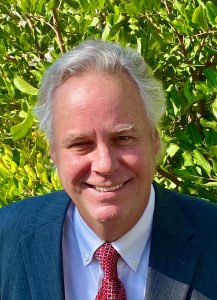
Flanigan’s Net Positive: Repair Cafes
Love this. Repair Cafes are free, community-run meeting places where locals can bring broken items for volunteers to fix. This spirited movement is smack in the face of gross consumerism and planned obsolescence.
Just a few decades ago, there were shops that repaired shoes, TVs, luggage, vacuum cleaners, and a number of other products. They’ve been wiped out in recent years. Repair Cafes are allowing people to breathe new life into broken things.
Frustrated with the throw-away culture, Dutch environmentalist, Martine Postma came up with the Repair Cafe idea in 2009. The concept took root in Amsterdam. It has now become a global movement with cafes in Belgium, Germany, France, the U.K., and the US, and beyond. As of 2018, there were 1,300 Repair Cafes in over 30 countries.
Repair Cafes match the needs of the people. Many early Repair Cafes focused on clothing repairs… with multiple sewing machines and their machinists busy at work for hours. A cafe might repair clothing one month, and then shift to electronics repairs the next. Repair items include electrical kettles, toasters, coffee makers, hair dryers, CD players, scooters, vacuum cleaners, hedge trimmers, and lamps. Some work on gardening tools while others repair jewelry, repairing broken clasps and restringing beads. Other items repaired: chairs, stuffed toys, suitcases, and umbrellas!

At some Repair Cafes there are spin-off activities for those whose materials are being repaired: Knife sharpening, seed-swaps, live music, haircuts, and massage chairs; classes on composting, chicken-keeping, backyard gardening, and resilience building initiatives. The Home Espresso Repair Cafe in Seattle on Phinney Avenue provides home espresso machine repair.
Every Repair Cafe is independent but all are guided and supported by Martine Postma’s non-profit Repair Cafe International (RCI). RCI offers a 49-Euro digital startup kit. It also takes donations for its work creating online content which features guidance on repairs. The organization also lobbies for goods to be more repairable.
So is there one near me? I see that Transition Pasadena has been supporting Repair Cafes in the form of “a free roving all purpose repair shop for and by the community.” I Googled and found out that its most recent event was days ago, January 27th at the Pasadena Senior Center. Closer: Just found out that we have Repair Cafes right here in Glendale! Check it out.

Repair Cafe Pasadena
Quote of the Month
“We estimate that the number of wind turbines in the ocean likely surpassed the number of oil structures by the end of 2020.”
Researchers from Global Fishing Watch, University of Wisconsin, Duke, UC Santa Barbara, and Skye Truth
Their study documents $1.5 trillion in oceanic activities from fishing, shipping, to energy each year.
2023 Electric Vehicle Notes
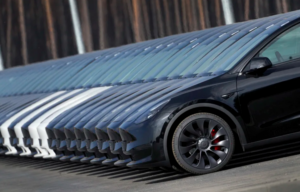
Global EV Sales: Some big numbers in 2023: Tesla manufactured 1.846 million EVs and delivered 1.809 million cars, beating its 2022 deliveries by 38%. Tesla’s Model Y was the best selling car in the world… marking the first time that an EV earned that designation.
BYD sold 1.6 million EVs in 2023, plus 1.4 million hybrids. Most of BYD’s EVs sell at lower price points than Teslas.
Norway tops all nations with 82.4% of all car sales EVs. One- third of all private vehicles in Oslo are 100% battery electric. The biggest brands after Tesla are Toyota and Volkswagen.

U.S. EV Highlights: In 2023, EVs were nearly 10% of all new car purchases in America, up from 2% in 2020. At this pace, EVs will make up half of all new car sales by 2026. In California, over 25% of all new car sales are EVs, up from ~7% in 2020.
In the United States, Kelly Blue Book reports that 1.2 million EVs were purchased in the United States last year. Tesla had 55% of the nation’s EV sales and 4.2% of the overall U.S. market with over 650,000 EV deliveries.
Hyundai owns 30% of Kia. Hyundai and Kia, while not technically the same company, have now surged ahead of Ford and GM to be the number two EV provider in the United States. Hyundai and Kia had sales of 117,000 units or 8% of the EV market last year. Meanwhile, Toyota – now with 26 EV models – more than doubled its EV sales.

Everything by Wire: The remarkable pace of innovation in the EV space continues. An Israeli company, REE, is now rolling out a medium-sized truck with a totally revolutionary automotive concept: It features “everything by wire” technology. Instead of a lot of mechanical parts, the REE EV platform begins with a chassis. Then it’s everything by wire. It has no engine or electric motor or drive train or steering rack or hydraulic braking system… or suspension system either.
Now imagine a chassis with four motor pods that are controlled electronically by the driver, or autonomously. Each pod – or what its manufacturer’s are calling “corner units” — has steering, suspension, electric drive motors, transmission, brakes, cooling and the wheels themselves built in. All controlled electronically, not mechanically.
The entire corner unit can be bolted on and off in seconds… reportedly as fast as a tire change. REE Automotive has now certified the first “x-by-wire” vehicle for use in the United States, receiving Federal Motor Vehicle Safety Standard certification and EPA approval. The result is wide-open cargo space.
Lithium-Free, Sodium-Ion Batteries: Sodium-ion batteries have a lower power density, but they’re cheaper and perform better in cold weather. JAC Motors, a Volkswagen-backed Chinese automaker, is about to release the first mass-produced EV with a sodium-ion battery. It will do so through its Yiwei brand. The Yiwei EV will have a 25 kWh battery pack and a range of 157 miles. The new cars will use cylindrical sodium-ion cells in a honeycomb structure, like CATL’s cell-to pack and BYD’s Blade battery configurations. VW has a 75% stake in JAC. It also has a 50% stake in its parent company; the other 50% is owned by the Chinese government.

2023 Renewables and Carbon

Renewable energy grew at its fastest rate worldwide in 2023, with growth that was 50% higher than the 2022 growth rate. In fact, this is the 22nd year in a row of record renewable energy growth. According to the U.S. Energy Information Administration, new additions of global renewable energy capacity reached 510 GW last year. By the end of 2023, there was nearly 4 TW of global renewable capacity.
Fully 75% of the 2023 growth was solar capacity. Europe, the U.S., and Brazil all exceeded their prior growth rates in solar. According to EIA, “China’s acceleration was extraordinary.” In 2023, China commissioned as much solar as had been commissioned worldwide in 2022. China also developed record-setting wind capacity.
Concurrently, solar prices dropped by 50% last year to historic low levels… 15 cents a watt. At InterSolar this month in San Diego, I was quoted panel pricing by a Jordanian company in the 22 – 25 cent per watt range. A report from Rethink Technology Research finds that panel prices, except the 2020 – 2022 pandemic years, have been falling 10 – 15% annually since the early 2000s.
Analysts believe that panel prices will continue to fall to 9 cents a watt by 2030 and 7 cents by 2040. The report sites more than $100 billion invested in solar manufacturing production since 2020. Another similar analysis finds that, “Solar energy is on track to make up more than half of global electricity production by the middle of this century – even without more ambitious climate policies.”
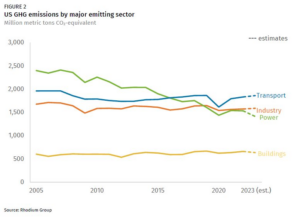
Carbon Emissions: Rhodium reports that in 2023, the U.S. experienced something it hasn’t since before the Covid-19 pandemic, a growing economy paired with shrinking greenhouse gas emissions. Rhodium research findings report that the U.S. build-out of renewable energy helped to curb emissions by 1.9% in 2023 while the economy expanded 2.4%. Solar projects and utility-scale battery installations contributed to an 8% drop in U.S. power sector emissions from 2022 levels.
Some more big domestic factors: Coal-fired generation hit a low last year… but there was more “fossil gas” used. (Fossil gas, the refreshed name for natural gas.) Due to a relatively mild winter, Americans used less fuel for heating. There was also an uptick in residential use of all-electric heat pumps. On the other hand, there were increased emissions in transportation driven in part by a post-pandemic rebound in jet fuel consumption.
The American 1.9% decline is a big step, but the U.S. needs a 6.9% reduction every year until 2030 to meet the Paris Agreement pledge to cut emissions in half by 2030. Jigar Shah noted that these reductions may not be linear… that the out years may be very strong after a weak ramp up. A report in Science showed that pre-IRA, the U.S. would achieve a 25 – 31% reduction. With the IRA the U.S. is poised to cut emissions by 33 – 40% by 2050, short of the mark, and thus in focus.
Win-Win Findings for Vehicle Grid Integration

Image Courtesy of Revel
Exciting news for those of us that see great potential for EVs to support power grids, and to do so in a win-win for drivers and utilities. Imagine your car as a mobile battery that can charge cheaply and discharge earning revenues while supporting your utility’s load curve and reliability.
A pilot Vehicle Grid Integration (VGI) program in Brooklyn, New York, sheds light on this scenario, and its potential. The study involves only three vehicles but its findings are encouraging: The National Renewable Energy Laboratory (NREL) analysis shows that EVs can earn money when participating in existing New York State distributed energy incentive programs.
New York State offers incentives for distributed energy resources such as solar, and in this case EV batteries, through its unique, astute, and complex “value-stack” system for distributed energy resources (DERs), called the VDER. The State’s VDER program pays incentives for five services. These values can be stacked.
In the pilot VGI program, three of the value stack’s five incentive tracks were combined. The cars reaped revenues for discharging and reducing demand when called upon. They also reaped “locational benefits,” special incentives for areas of the grid that the utility needs to shore up. Third, they got capacity payments for discharging coincident with peak demands.
The study found that the most lucrative of the three was the first, the demand reduction value. In the summer of 2023, there were nearly 60 days when Consolidated Edison paid incentives for the vehicles’ exports between 2 – 6 on non-holiday weekday afternoons.
Revel installed the 15 kW bidirectional chargers for the Leafs’ 62 kWh batteries. Other project partners were NineDot Energy and Fermata Energy. NREL provided the programming to determine the best times and locations to send energy from the EVs to the grid. The analysis reinforced the win-win opportunity at hand, the potential for the EV-driving public to shore up the grid. And since EVs are not regulated by the fire department, the study’s authors note that it may well be easier to cite EVs’ batteries in the urban environment than stationary batteries to address peak demands.
Brooklyn Clean Energy Hub
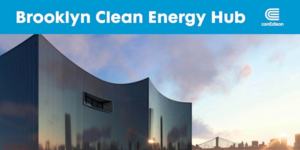
Also in Brooklyn, in the Vinegar Hill area, a former and most formidable power plant has been raised and in its place will be the Brooklyn Clean Energy Hub. Instead of generating power on site, the Hub will serve as a receiving station for offshore wind. Some call it the “plug-in point.” Initially it will be able to receive 1,500 MW of offshore wind power, then up to 6,000 MW in the future.
The Hudson Avenue Generation Station was famous in its day, built from 1924 – 1931, by the Brooklyn Edison Company. The 92-year old brick building there housed the largest electric generator and commercial steam plant in the world at the time of its completion. The plant had 770 MW of capacity, burning fossil fuels for almost a century. It was a pioneer in the cogeneration of power and steam, steam that it sent in tunnels under the East River to Manhattan. At the end of its life, in 2011, Consolidated Edison closed the plant to clean its emissions from the combustion of dirty and expensive Number 6 fuel oil.
The new Hub’s architecture is sleek and modern and will be quite visible. Some say it will beautify Brooklyn’s waterfront. The building is LEED certified. It will have a green roof and rooftop solar array, and it will be sited five feet higher than the 100-year flood elevation criteria. It will also be able to withstand 130 mph winds. The Hub will disperse power using a network of underground transmission lines to various locations. Part of the power will fulfill the power requirements of John F Kennedy Airport’s expansion.
Mandatory Biowaste Separation and Composting in France

Compulsory composting is in effect to slash emissions in France. As of January 1, 2024, organic waste recycling is mandatory there. The new “compost obligatoire” rules require separation of organic wastes on site. Prior to the new rule, only those restaurants, businesses, and institutions that generated more than 5 tons per year were required to separate organic wastes from the general waste stream.
With support from the French government’s Green Fund, municipalities must now provide residents with ways to sort bio-waste including food scraps, vegetable peels, expired food, and garden waste. The obligation now is on local authorities to provide means for residents to comply. The waste will be turned into biogas or compost to replace chemical fertilizers.
Organic waste from food and gardens accounts for one-third of household waste. It typically ends up in landfills where it releases methane, or incinerators where it releases CO2. In 2018 only 34% of the European Union’s total biowaste was collected, 40 million tonnes of potential soil nutrients were discarded that year. Under the EU’s Waste Framework Directive, biowaste collection is encouraged but there are no mandatory targets. Milan has been a leader in this regard with biowaste separation since 2014. Now France is stepping forward.
Utility Innovation, Octopus Style!

Octopus Energy is the United Kingdom’s largest electricity retailer. It has grown to be a force in Europe. Using Artificial Intelligence and an Uber-based approach, it is building a new power system to control supply and demand of electricity.
The British conglomerate entered the U.S. market in 2020 in Houston and in the Silicon Valley. Octopus is ramping up its focus in Texas using its renewable energy management system to offer cheaper prices to customers that agree to allow its control platform to shift demand from times of shortage to when there is abundant supply.
Octopus explains that grid management used to be simple: Turn on and off power plants accordingly. But now the power system has evolved and is made up of numerous and widely dispersed solar and wind farms, grid-scale storage, inter-regional connections, and in the future with more and more grid-connected EVs with charged batteries on board.
Just as Uber built its system around forecasting when and where drivers are needed, Octopus is using its Kraken AI system to develop models to serve power. It aggregates customers who are open to flexible offers.
Octopus is now valued at $7.8 billion. Its retail base has doubled in two years through rival acquisitions. The group’s businesses include “EV listening,” installation of smart meters and EV chargers, heat pump manufacturing, and a multi-billion-dollar renewable generation business.
Octopus supplies 11% of the EVs in Britain, most of these have chosen its smart charging option. Thanks to a “shiftable load,” Octopus can cut charging costs by 75%. Octopus even has a “fan club” that offers customers cheaper power when the Octopus wind turbines are turning full bore.
Recycling Solar Panels
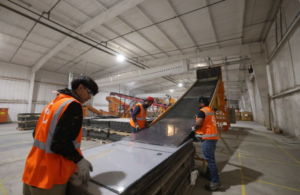
Believe it or not, the first generation of solar panels are now wearing out. In many cases they are being eclipsed by larger and more powerful units. So what to do with obsolete panels? Landfilling of spent panels has been the norm. According to a University of Virginia professor, by 2050 solar waste could amount to 78 million tons globally. The EPA expects as much as a million tons of solar panel waste per year by 2030. Right now, recycling panels costs as much as $30 per panel versus a $1/panel landfilling cost.
Intro We Recycle Solar, a firm established to repurpose and recycle solar panels. Founded in 2019, it has recycled or remarketed more than 500,000 solar panels. Its Yuma processing facility takes in panels from all over the country. The head of the company, Adam Saghei, notes that, “ green technology doesn’t stay green once it is decommissioned or retired.” It must be purposefully addressed. In Yuma, panels are gently separated and sorted by brand and model. Fully 60% are slated for testing and reuse. The company reports that customers around the world are seeking refurbished panels for their affordability.
Panels that do not go to testing and resale, head down a conveyor belt… where glass metals and other materials with value are separated. Robotic suction arms are used to separate the glass from other materials. The highest-value materials are copper, silver, aluminum, glass, and crystalline silicon. The Yuma facility can process 7,500 panels/day, ~69 million pounds of PV per year. It has six collection locations across the country and a main collection point in Hackettstown, New Jersey.
Batteries Bury Coal in Hawaii
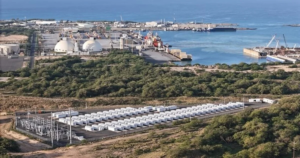
Celebrated this article shall be. Hawaii has closed its last coal plant, a 180 MW baseload plant on Oahu. Hawaii’s last shipment of coal arrived in July 2023. It’s now spent. Coal, thanks to Hawaiian legislation, is now a thing of the past. And in its place… renewables and big batteries. The last coal plant was replaced with a record-sized battery installation to store intermittent renewable energy.
The Kapolei Energy Storage facility is 20 miles west of Honolulu. Located on eight acres of industrial land, white storage sheds are lined up, each the size of a shipping container, housing the batteries. Plus Power’s Kapolei battery facility is made up of 158 MW of Tesla Megapacks with 565 MWh of storage. Its 185 MW of discharge capacity is nearly instantaneous. The battery plant matches what the old coal plant could deliver, but lickety-split, it has a 250-millisecond response time. The installation can supply 17% of the island of Oahu’s demand for three hours, or six hours at half load.
In 2022, Hawaii implemented another innovative plan to support the move to shut down the State’s last coal plant, this one relying on the people. The Battery Plus program was launched. It subsidized households to install rooftop solar with batteries. In exchange, participating households feed power back into the grid at certain times when called upon to do so, for two-hour periods in the evening between 6 and 8:30 pm. By the end of 2023, 40 MW of capacity was enrolled in the program on Oahu; Maui enrolled over 6 MW.
Flanigan’s Ego-Logic Podcast Updates
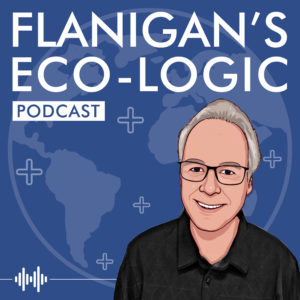
Use the links below to check out our recent podcasts. And you can always go to Spotify and type in “Ted Flanigan” to find our library of podcasts.
Recently Released:

In EcoNet News, Volume 26, Issue #1, Ted shares his love for Repair Cafes, free, community-run meeting places where locals can bring broken items for volunteers to fix. He also shares 2023’s EV highlights, from global EV sales to the release of the first mass-produced EV with a sodium-ion battery, as well as 2023’s growth in renewable energy and shrink in GHG emissions. Ted goes on to highlight win-win findings for VGI, Brooklyn’s Clean Energy Hub, mandatory biowaste separation and composting in France, Octopus Energy’s utility innovation, recycling solar panels, and batteries burying coal in Hawaii.
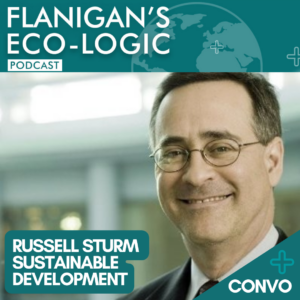
In this episode of Flanigan’s Eco-Logic, Ted speaks with Russell Sturm, Professor of the Practice at University of Virginia, University of North Carolina/ Chapel Hill, and California Polytechnic Institute /Humboldt. He is also an advisor for the off-grid solar industry. Russell is an innovator in the field of sustainable energy market development, and has been a sector leader across international multilateral institution, private sector, and NGO professional platforms over a 35-year career mobilizing investments in clean energy technologies.
He is the creator of the Lighting Global program, which has catalyzed the global off-grid solar industry that has to date attracted private investments and has enabled 500 million people to emerge from energy poverty and avoided 200 million tonnes of GHG emissions by providing affordable, clean modern solar electricity household and productive use of energy services.
Today, Russell continues to advise the off-grid solar industry that he helped to create. In addition, his primary focus is on supporting the development of the next generation of students and young professionals who will carry forward his vision of universal energy and clean water access enabled by a global economy built on a foundation of sustainable technology.
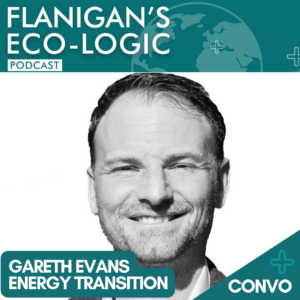
In this episode of Flanigan’s Eco-Logic, Ted speaks with Gareth Evans, CEO and Founder of VECKTA, a platform and team of experts that accelerate and simplify the deployment of onsite energy solutions for businesses globally. With 20 years of experience in the energy and resource sectors, he is an expert in microgrid and distributed energy planning and design, construction and monitoring.
Gareth led Worley’s Global Distributed Energy Systems strategy and Power Networks & Systems team, ending up in the Middle East following the Gulf War, which set his mission in motion; it opened his eyes to a world without access to reliable energy and other basic essentials needed to survive. He saw the impact that can have on the stability of a region, and the health and success of businesses and communities. Driven by this experience, he committed himself to find solutions that create profitable and sustainable energy outcomes such that everyone can thrive.
Helping Worley and its clients successfully navigate energy transition, Gareth sought out to empower businesses and communities make the global transition towards a more affordable, secure, and renewable energy future through VECKTA. VECKTA’s platform empowers businesses to make data-driven decisions in their energy transition journey. Gareth and Ted discuss his business model, real life examples of businesses harnessing the power of onsite energy solutions, such as wineries and mines, and the future of resilience.
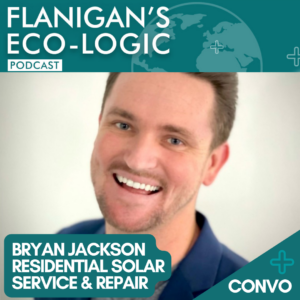
In this episode of Flanigan’s Eco-Logic, Ted speaks with Bryan Jackson, Vice President of Sales for EnergyAid, a leading provider of high-quality service, maintenance, tune-ups, and system evaluations for residential solar customers.
EnergyAid bridges the gap and offers dependable assistance, ensuring residential solar investment operates at its peak. The management of EnergyAid has collectively over 100 years of experience in the solar power industry and is passionate about making sure system owners realize their expectations when it comes to system performance, utility bill reductions, and a positive effect on greenhouse gasses.
He and Ted discuss the future of the solar industry, as Bryan points out is still in its infancy, and EnergyAid, which he predicts will be part of the service-first business model as it continues to mature. The company is expanding across the Western states, and has recently opened a location in Arizona. They are also working with new technologies, such as EV charging, which is a large component of the future.

In this episode of Flanigan’s Eco-Logic, Ted speaks with Bill Browning, Bill Browning, Founding Partner of Terrapin Bright Green, a sustainability consulting firm that helps governments, corporations, and complex real estate projects meet sustainability goals that lead to the improved health and wellbeing of employees and ecosystems, as well as the enhanced performance of their products and systems.
Bill is one of the green building and real estate industry’s foremost thinkers and strategists, and an advocate for sustainable design solutions at all levels of business, government, and civil society. His expertise has been sought out by organizations as diverse as Fortune 500 companies, leading universities, non-profit organizations, the U.S. military, and foreign governments.
He defines biophilic design and shares case studies that demonstrate the effects that harmonizing the built environment and natural world have on cognitive growth, health and wellbeing, and profitability and productivity within the business sector. Terrapin’s work is reflective of both the culture of the community and the environmental features of a given ecosystem.
